Emma Jameson – 8 October, 2014
Sam Mitchell's ceramics are quirkily beautiful in their contrast between intricate patterns and simplified, stark outlines designating bold forms. In both subject and style they hint at a time period that seems simultaneously vintage and modern. Traditions and its transgressions are subtly interweaved to create art objects that are striking in both their aesthetic appeal and connotations of a socially critical narrative.
Auckland
Sam Mitchell
One of Us Cannot Be Wrong
24 September - 18 October 2014
Then I took the dust of a long sleepless night and I put it in your little shoe
And then I confess that I tortured the dress that you wore for the world to look through
The traditional and kitsch are beautifully merged in Sam Mitchell’s ceramics currently on display at Melanie Rogers. Taking its name from the Leonard Cohen song “One of us cannot be wrong”, Mitchell’s ceramics seem to exude the dark-humoured mystique and sultry nostalgia of the prolific song-writer’s music.
Painted in primary red and blue, Mitchell’s designs strikingly contrast against the pale cream of their background. Depicted with economic strokes, the figures boldly assert their presence against the backgrounds of smaller, more intricate cross-hatching and circular strokes. Different textures and time periods are evoked, elevating the ceramics to a state of timeless relevance.
Mitchell’s kitsch, almost ironic subjects seem to have been taken from the cultural fabric of the 1950s and 1960s. The three astronauts from the first moon landing in 1969 stare out at the viewer from their bold red background, women look shocked and intrigued by Kinsey’s pivotal 1953 Book on Women (presumably alluding to his book Sexual Behaviour in the Human Female), and a monkey holds up a newspaper bearing the headline “JFK Wins Fight”. An old-world glamour is evoked. The simplified, darker outlines of the figures seems to visually parallel book illustrations and comic books of the era such as those seen in the Nancy Drew series or the Love and Marriage comics. One ceramic plate in particular, Untitled (Watching Couple), immediately reminded me of the composition and expression seen in Cindy Sherman’s Film Still #14. The two figures stare out with a look of concern at a point in the distance beyond the viewer. The boldly painted black grid on the red background behind them seems to allude to either a cityscape or a vortex from a science fiction film.
By incorporating these figures within a format and medium traditionally reserved for conservative portraits and landscapes (ie. the Wedgewood ceramics), Mitchell seems to be subjugating her subjects to a tongue in cheek comic critique. These plates are an ironic and wry investigation into the ideals of a certain cultural context and the pervasive attitudes that they reveal. Mitchell’s objects, displayed on old wooden school chairs, have been arranged in a way that beautifully offsets their chromatic vibrancy and alludes to a certain narrative speaking of the mood of times’ past.
Societal construction of femininity is consistently satirised. Miss Invercargill features a topless woman staring out at the viewer. The bold strokes with which her chest has been painted boldly asserts her sexualised nature. Yet this figure is not the idealised type of woman we would expect to have won a beauty pageant title. Her blank white eyes transform her into an other-worldly, disembodied figure who could metamorphose into a strange creature at any moment. Recalling the femme fatale figure prevalent in the film-noir era of the 1940s and 1950s her overtly sexualised figure seems to parody the paradox expected of women during this time: to be coy and alluring but not transgress this through self-possession and awareness of this power.
Red plates showing first a scientist examining an atomic structure and then a scientist constructing a fem-bot follow this. This short series comes full circle with the final blue dish, which again shows Miss South Land. Again, she is blank-eyed, staring out at us from a simple, grid background. The depiction of women in 1950s popular culture, particularly in science fiction films, seems to be alluded to here. The fem-bot became a stock subject in lurid pulp science fiction magazines throughout the 1970s, acting as a metaphor for societal insecurities about the relationship between the sexes in its signification of a dangerously powerful, sexualised woman (ie. Stepford Wives). A constructed figure within science fiction fantasy, the fem-bot stands for the ways in which the male populace controls the depiction of the female figure. This manipulation is alluded to by the presence of the male scientist in the second and third objects.
Constructions of femininity are more subtly alluded to throughout the exhibition. Untitled (Beauty Queens) features five identical caricature-esque women who are posing at the forefront of the picture plane. In Woman With Father, Husband, Sir, Mr, a woman’s angular face is surrounded by smaller images of men, the implication perhaps being that these are the men whose identity shapes her own position within society. In format these plates recall traditional ceramics displaying family portraits or family trees. Yet Mitchell’s angular, almost comic book style has the effect of subtly transgressing the propriety associated with these forms of visual tradition.
Sam Mitchell’s ceramics are quirkily beautiful in their contrast between intricate patterns and simplified, stark outlines designating bold forms. In both subject and style they hint at a time period that seems simultaneously vintage and modern. Traditions and its transgressions are subtly interweaved to create art objects that are striking in both their aesthetic appeal and connotations of a socially critical narrative.
Emma Jameson is the 2014 EyeContact Artists Alliance Writing Intern, a programme made possible with generous funding from the ASB Community Trust.
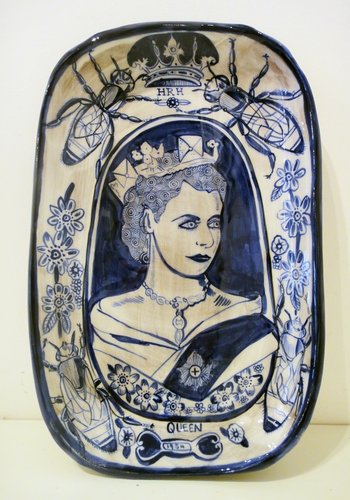
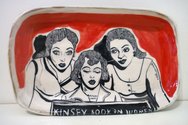
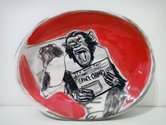

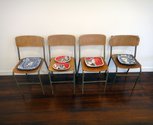
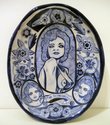
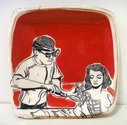
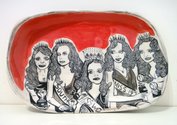
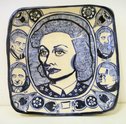
 Two Rooms presents a program of residencies and projects
Two Rooms presents a program of residencies and projects Advertising in this column
Advertising in this column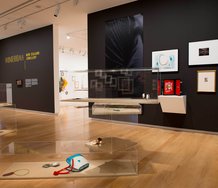
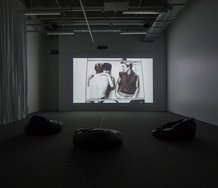


This Discussion has 0 comments.
Comment
Participate
Register to Participate.
Sign in
Sign in to an existing account.